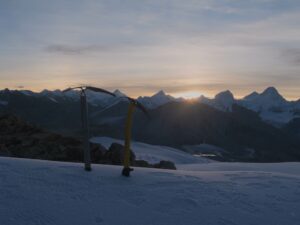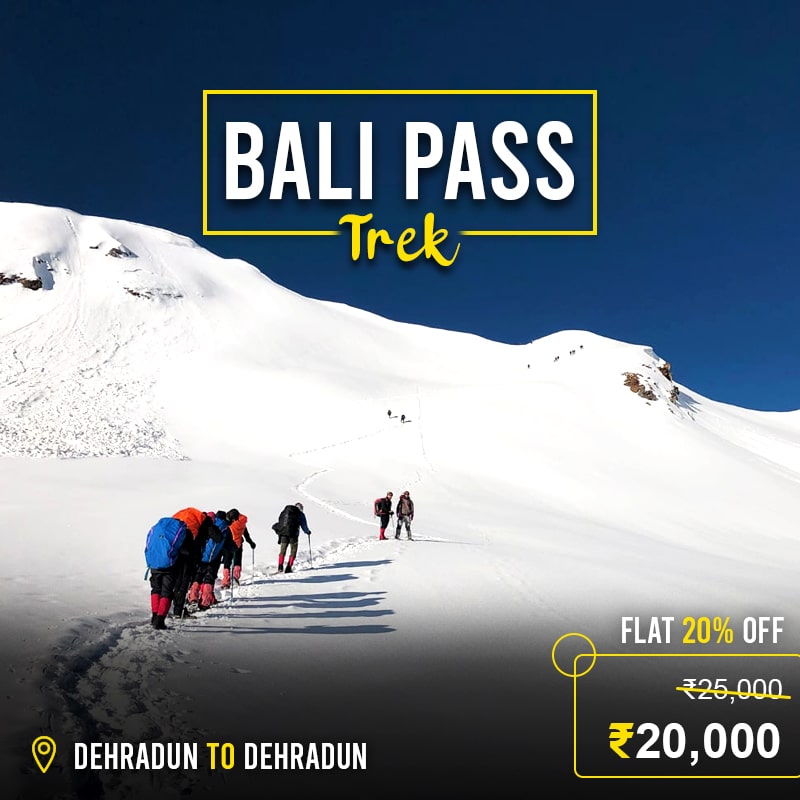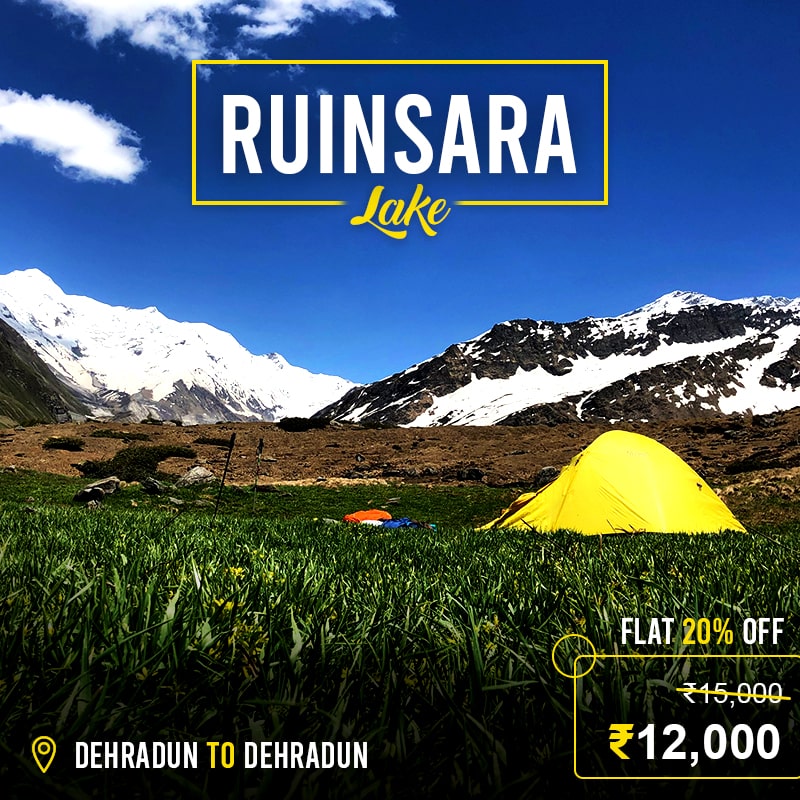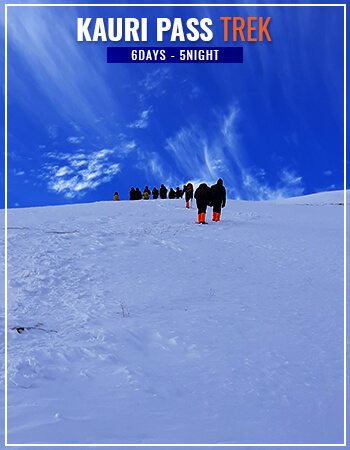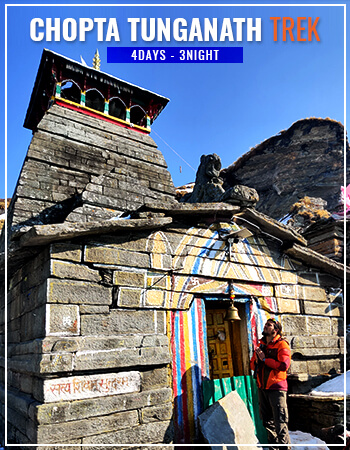KALINDI KHAL TREK
12 Days - 11 Night
12 Days - 11 Night
19,450 ft.
Moderate - Difficult
Gangotri
ABOUT
Kalindi Khal TREK
The Kalindi Khal Trek connects Gangotri and Badrinath and is an incredibly difficult expedition-style traverse of the Kalindi Khal Pass in the magnificent Garhwal Himalayas. A trek through rugged glaciers, rocky windows, and crevassed snowfields is part of the way. We occasionally need to rope up, which necessitates the use of ice axes and crampons. From the Bhagirathi Valley to the Alaknanda Valley, the Kalindi Khal trek takes you halfway across Garhwal. Shivling at 6,543 metres, Meru at 6,630 metres, Kedar Dome at 6,808 metres, Bhagirathi party at 6,856 metres, Nilkantha at 6,506 metres, Chandra Parvat at 6,728 metres, Avalanche Mountain at 6,413 metres, Kamet at 7,756 metres, Mana at 7,272 metres, and Abi Gamin at 7,355 metres are among the tallest and most magnificent peaks in the Indian Himalayan range While no previous climbing experience is needed, this is one of our most Read More
SHORT ITINERARY
-
DAY 1
Gangotri Arrival
-
DAY 2
From Gangotri towards Bhojwasa
-
DAY 3
From Bhojwasa towards Tapovan via – Gomukh
-
DAY 4
From Tapovan towards Nandanvan via Meru Glacier
-
DAY 5
From Nandanvan towards Vasuki Tal
-
DAY 6
From Vasuki Tal towards Khara Patthar
-
DAY 7
From Khara Patthar towards Sweta Glacier
-
DAY 8
From Sweta Glacier towards Kalindi Base Camp
-
DAY 9
From Kalindi Base Camp towards Rajaparav via Kalindi Khal
-
DAY 10
From Rajaparav towards Arwa Tal
-
DAY 11
From Arwa Tal towards Badrinath via Ghastoli
-
DAY 12
From Badrinath towards Dehradun
DETAILed ITINERARY
Day 1: Gangotri Arrival
Gangotri can only be reached by road. By 3 p.m., you should have arrived. The road journey can begin in either Dehradun or Rishikesh, but with a new route now available, reaching Gangotri via Dehradun is the quickest choice (around 242 Kms). We will send you information about accommodation in Gangotri via email. Check into the Guest House/Hotel until you arrive. Rest for a while. The evening can be used to visit the nearby market, churches, and other attractions.
Day 2: From Gangotri towards Bhojwasa
We begin our trek towards Chirbasa after breakfast in the morning (3600 m). We can go from Gangotri to Chirbasa by following the beaten path. The Bhagirathi River runs through the whole trek before Chirbasa. In Chirbasa, we will eat our packed lunch. Today we continue our trek from Chirbasa to Bhojwasa. For the rest of the day, the hike would be mild. After Chirbasa, the landscape turns bleak and dry. Before Bhojwasa, the entire path passes through thick woodland. Near the water, there is a small temple and a possible campsite. It’s a nice spot to set up camp for the day.
Day 3: From Bhojwasa towards Tapovan via – Gomukh
In the morning, enjoy the Bhagirathi group of peaks. Trek to Gomukh (3890mt), the Ganges’ source, after breakfast. The Ganga’s water trickles down from the glaciers at Gomukh. Explore the area and hike to Tapovan, one of the area’s most beautiful high-altitude alpine meadows. The climb from Gomukh to Tapovan is steep, and the view of the nearby peaks improves as we ascend. Tapovan is a great treat with a vast meadow complete with bubbling streams, wildflowers, and campsites. Tapovan is renowned for its spectacular meadows that encircle the base camp of the Shivling mountain. Arrive in Tapovan and pitch your tent. Staying in camp for dinner and rest at night.
Day 4: From Tapovan towards Nandanvan via Meru Glacier
On this day, we get up early and go to the magnificent Meru Glacier. We return to Nandanvan via Gomukh glacier after a brief stop to explore Meru Glacier. The path from Tapovan leads down and onto the glacier, passing through the upper part of the meadow. Turn right from Gomukh towards Nandanvan (4340m) and you’ll be on top of the Gangotri glacier. The glacier is sandwiched between two mountain ranges, and landslides have created a layer of rocky moraine on the ice that makes walking easier. The glacier walk is very slick, and even a minor lapse of focus may be fatal. Huge chasms could be seen here and there. There is a vertical climb after around a kilometer of walking. Big rocks along the trail provide grip and footholds, but many of them are still misleading. Tents were used for dinner and the night.
Day 5: From Nandanvan towards Vasuki Tal
Vasuki Tal, a beautiful base for Mt Satopanth and Mt Vasuki Parbat with a small lake, is reached through a morning trek along the Chaturangi Glacier. The ascent is gradual but slow. Take a rest and spend the night.
Day 6: From Vasuki Tal towards Khara Patthar
Today’s hike will last 6 hours. The view of Mount Sathopanth is enough to make the trip worthwhile. It is one of India’s only two peaks with a height of over 7000 meters.
Day 7: From Khara Patthar towards Sweta Glacier
The hike today is just a few miles long. The campsite is a moraine region full of rocks and boulders; it’s not perfect, but it’s essential for acclimatization.
Day 8: From Sweta Glacier towards Kalindi Base Camp
Today would be an early day for us. It’s a short hike, but with the majority of the trek taking place in the moraine, it’s still a smart idea to plan ahead. On the way, you’ll pass by Chatrungi Glacier, which received its name from the four colors that can be seen there (pink, purple, brown, and green). This glacier’s glacial flow is a major tributary to Gangotri Glacier. Today’s camping spot is Kalindi Bhamak, which is next to the Kalindi Glacier’s snout. Avalanche and Kalindi Peak are just up there, and Kalindi Khal/Pass is just up ahead.
Day 9: From Kalindi Base Camp towards Rajaparav via Kalindi Khal
Today is D Day, and everybody can get up and ready as soon as possible. The climb to the pass is not easy by any means, so we must maintain a steady pace before we hit the top. When you cross the pass, you will know that all of your toil and effort were well worth it. On a clear day, you will see Mt. Kamet, Mt. Mana, Chandra Parbat, Vasuki Parbat, and, on a clear day, the Tibetan Plateau. After navigating the glacial terrain, we’ll camp at Raj Parav today.
Day 10: From Rajaparav towards Arwa Tal
Arwa Tal is reached after a long walk over glacier terrain.
Day 11: From Arwa Tal towards Badrinath via Ghastoli
We will arrive in Ghastoli and the landscape will change from grey to green. Ghastoli is a lovely meadow that is a visual delight. Drive to Badrinath via the Mana Pass route.
Day 12: From Badrinath towards Dehradun
We’ll board a bus bound for Dehradun. The Alaknanda River runs through Devprayag, where it reaches the Ganges, on the way to Dehradun. From Dehradun, take an overnight bus to Delhi.
subscribe Now
DETAILed ITINERARY
Day 1: Gangotri Arrival
Gangotri can only be reached by road. By 3 p.m., you should have arrived. The road journey can begin in either Dehradun or Rishikesh, but with a new route now available, reaching Gangotri via Dehradun is the quickest choice (around 242 Kms). We will send you information about accommodation in Gangotri via email. Check into the Guest House/Hotel until you arrive. Rest for a while. The evening can be used to visit the nearby market, churches, and other attractions.
Day 2: From Gangotri towards Bhojwasa
We begin our trek towards Chirbasa after breakfast in the morning (3600 m). We can go from Gangotri to Chirbasa by following the beaten path. The Bhagirathi River runs through the whole trek before Chirbasa. In Chirbasa, we will eat our packed lunch. Today we continue our trek from Chirbasa to Bhojwasa. For the rest of the day, the hike would be mild. After Chirbasa, the landscape turns bleak and dry. Before Bhojwasa, the entire path passes through thick woodland. Near the water, there is a small temple and a possible campsite. It's a nice spot to set up camp for the day.
Day 3: From Bhojwasa towards Tapovan via – Gomukh
In morning, enjoy the Bhagirathi group of peaks. Trek to Gomukh (3890mt), the Ganges' source, after breakfast. The Ganga's water trickles down from the glaciers at Gomukh. Read More
Day 4: From Tapovan towards Nandanvan via Meru Glacier
On this day, we get up early and go to the magnificent Meru Glacier. We return to Nandanvan via Gomukh glacier after a brief stop to explore Meru Glacier. Read More
Day 5: From Nandanvan towards Vasuki Tal
Vasuki Tal, a beautiful base for Mt Satopanth and Mt Vasuki Parbat with a small lake, is reached through a morning trek along the Chaturangi Glacier. The ascent is gradual but slow. Take a rest and spend the night.
Day 6: From Vasuki Tal towards Khara Patthar
Today's hike will last 6 hours. The view of Mount Sathopanth is enough to make the trip worthwhile. It is one of India's only two peaks with a height of over 7000 meters.
Day 7: From Khara Patthar towards Sweta Glacier
The hike today is just a few miles long. The campsite is a moraine region full of rocks and boulders; it's not perfect, but it's essential for acclimatization.
Day 8: From Sweta Glacier towards Kalindi Base Camp
Today would be an early day for us. It's a short hike, but with the majority of the trek taking place in the moraine, it's still a smart idea to plan ahead. On the way, you'll pass by Chatrungi Glacier, which received its name from the four colours that can be seen there (pink, purple, brown, and green). This glacier's glacial flow is a major tributary to Gangotri Glacier. Today's camping spot is Kalindi Bhamak, which is next to the Kalindi Glacier's snout. Avalanche and Kalindi Peak are just up there, and Kalindi Khal/Pass is just up ahead.
Day 9: From Kalindi Base Camp towards Rajaparav via Kalindi Khal
Today is D Day, and everybody can get up and ready as soon as possible. The climb to the pass is not easy by any means, so we must maintain a steady pace before we hit the top. When you cross the pass, you will know that all of your toil and effort was well worth it. On a clear day, you will see Mt. Kamet, Mt. Mana, Chandra Parbat, Vasuki Parbat, and, on a clear day, the Tibetan Plateau. After navigating the glacial terrain, we'll camp at Raj Parav today.
Day 10: From Rajaparav towards Arwa Tal
Arwa Tal is reached after a long walk over glacier terrain.
Day 11: From Arwa Tal towards Badrinath via Ghastoli
We will arrive in Ghastoli and the landscape will change from grey to green. Ghastoli is a lovely meadow that is a visual delight. Drive to Badrinath via the Mana Pass route.
Day 12: From Badrinath towards Dehradun
We'll board a bus bound for Dehradun. The Alaknanda River runs through Devprayag, where it reaches the Ganges, on the way to Dehradun. From Dehradun, take an overnight bus to Delhi.
subscribe Now
Get Quote
DEPATURE DATE
Call- +91-8979108941 | +91-9458118063
Call- +91-8979108941 | +91-9458118063
Call- +91-8979108941 | +91-9458118063
Call- +91-8979108941 | +91-9458118063
Call- +91-8979108941 | +91-9458118063
COST INCLUSION
-
Pick and Drop Service from mentioned location
-
Fees for the guide and the chef
-
Camping facilities' rent
-
Entrance fees to the forest
-
To transport camping gear, a porter and mule are required. Please keep in mind that personal baggage can be borne by mules and/or porters for a fee
-
From the first day's dinner until the last day's brunch, both of the meals are vegetarian
-
Throughout the walk, you'll be staying in a tent or if possible, then in a guest house
COST EXCLUSION
-
No pickup and drop point from/for your hometown
-
Personal costs include things like tips, personal medications, and conference calls, etc
-
Apart from what is mentioned above, some transportation assistance during the trek
-
Porters/mules can carry personal luggage weighing up to 12 kg per bag per person for Rs 350 per day per bag
Frequently asked question
- Footwear: The trekking boots which must be waterproof and snow proof, normal boots, floaters, and woolen socks.
- Backpack: (50 ltr), Daypack (20-30 ltr), Duffel bag.
- Clothes: Jacket and trousers that are both waterproof and breathable. Jacket (synthetic or down feather fleece), synthetic insulated trousers, poncho, sweatshirt, inner thermal (upper & lower), fleece, t-shirts, cotton trekking pants, shorts
- Season wise Clothes:
- Hand and head protection includes liner gloves, bandannas, sun hats, woollen caps, and face masks, among other things.
- Accessories: Sunglasses/goggles, anti-glare lenses, water bottle, hydra bag, and headlamp with spare bulb and extra batteries are all recommended.
- Trekking Gears: Toolkit for an emergency. Sunscreen, a toiletry pack, water purification pills, Ziploc packs, ear plugs, first-aid kit, and the necessary medications are all recommended.
- Camping Equipment: Sleeping bags of lining (extreme -5 to +5 Celsius if you have one), trekking sticks, and so on.
- Warm top/light micro fleece pullover/full sleeve T shirt – 2/3
- Water resistant/repellent trekking pants with an inner lining for added warmth- 2 High-quality windproof/water-resistant outer shell (jacket) with a proper hood
- Thick Fleece / Full-sleeve Woollen Jumper, Down Jacket with at least 600 fill capacity Innerwear with a thermal component (upper and lower)
- Woolen hat, inner fleece gloves, and outer water-resistant gloves
- 4–5 pairs of thick woollen socks and standard socks, scarf/muffler (optional)
- Waterproof Trekking/Hiking shoes with a thick heel and high ankles that are comfortable to wear. Sneakers/sport shoes are ideal for camp.
- Poncho or raincoat. A small, light-weight towel
- A hydration pack and an insulated water bottle (optional)
- Sunglasses with UV cover and the potential to cut light, as well as a cap or floppy hat to shield the strong sun off your skin (important when traversing through snow)
- Trekking pole or sturdy walking stick Lip Balm, Sunscreen Lotion
- Flashlight / torch (with extra batteries) Medications, if any special prescription is needed Toiletries for personal use
- Carry a rain cover over your luggage • Day pack/small bag that you can carry on your back all day to keep your essentials in
- Keep a few poly bags or plastic containers in your bag to place your things in if you need to in case of heavy weather.
Personal Medical Kit (MANDATORY FOR ALL)
- 10 Diamox tablets (to prevent AMS)
- Nifedipine – 5 pills Dexamethasone – one strip
- 6 tablets of Crocin (fever)
- 4 tablets of avomine (motion sickness) 4 capsules of Avil 25mg (allergies)
- 4 tablets of Combiflam (Pain killer)
- 6 tablets each of Norflox TZ and Lomofen (diarrhea) 10 tablets of Digene (acidity)
- 10 Omez/Rantadine capsules (antacids) 3 to 5 metres of crepe bandage
- 1 tiny roll of gauze 10 strips of bandage 1 small roll of cotton 10 packets of ORS
- Moov spray Betadine or other antiseptic cream (aches, & sprains)
- If you're vulnerable to knee injuries, you should wear a knee cap. Powder with antifungal properties
- Cancellation: If a trek is cancelled at the last minute due to a natural disaster or unforeseeable circumstances (such as floods, earthquakes, landslides, attack, or bandh), Discoveryhike will have a trek voucher for the full number. The voucher can be used for the same or a different trek over the next year.
- In case you wish to cancel the trek, then please be aware of these things:
- Cancellations made within 30 days of the trek's launch date will include a complete refund.
- If you cancel within 30 and 20 days before the hike, you will get a 50% refund.
- There will be no refund if you cancel less than 20 days before the trek begins.
- Please keep in mind that if you get a refund, there will be a reduction of 4% (Cancellation charges) from the overall amount you pay. In addition, if you purchased trek insurance, you would not get a refund.
- Discoveryhike assumes no responsibility for any malfunction or injury to your clothes, supplies, or other belongings while on the trek. The trek fee covers all expenses associated with the trek from start to finish.

